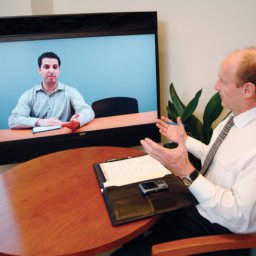Original Post by Denis Collins
Among our running themes for this blog is digital business transformation, which analysts from the MITSloan Management Review define as “use of technology to radically improve performance or reach of the enterprise.”
The type of technology that leads or drives digital transformation differs from industry to industry. For manufacturing, robotics is the vanguard. With payment cards, embedded chips take the driver’s seat. And for business communications, the engine of change is wireless devices and the mobility they bring to companies of all shapes and sizes.
Mobile conferencing is transforming how we work and paving the way for other types of digital collaboration that mix multiple media modes into one virtual setting. This technology-led process is more than a matter of hardware and software. Interacting more and more often in virtual settings is transforming not only our means of connection, but the way we talk and relate to each other.
Gauging the level of attention and/or engagement in a meeting is trickier when participants are not sitting in the same room. Virtual settings, our research indicates, make us more vulnerable to distraction. Moreover, nonverbal cues, such as body language, that are readily apparent when face to face are more difficult to detect at a digital distance.
Under virtual conditions, even routine business conversations, such as regular updates, require more deliberate planning and different delivery techniques to ensure efficient discussions and effective outcomes. And, yes, with today’s increasingly mobile workforce, audio-only conferencing often will be your most expedient and cost-effective method of holding meetings. But, when sensitive and/or complex topics come to the fore – such as deal or salary negotiations, confidential financial or performance reviews, and intricate exchanges like editing a lengthy document – setting the best tone for an interaction may require diversifying virtual modes.
Here are three sensitive and/or complex situations we believe benefit from including video and online collaboration tools in your virtual meeting’s mix:
1. When Proprietary is the Point
True, sending marked up, encrypted documents through private digital channels lends an air of assurance when managing confidential matters. But as we’ve explored on this blog in the past, text-only communication can lack nuance and subtlety. Adding a face-to-face dimension to ear-to-ear interactions can elevate attention and engagement from participants during, for example, contract revisions. Eye contact and body language can foster trust and convey authenticity more readily than secure documents. Plus, sharing a screen while explaining edits not only lends clarity, it can illuminate intent, too.
2. When Persuasion is the Priority
A video connection provides a powerful channel for telling stories, and storytelling is an elemental part of human interaction, as Susan Weinschenk explains in her “Brain Wise” column for Psychology Today:
“Everyone likes stories. We like to listen to stories, read stories, watch stories (movies, TV, theatre) and tell stories. In fact, stories are our normal mode of information processing.”
Which is why delivering a remote sales presentation via live video feed running next to a window sharing dynamic graphics can generate an edge over competition that’s narrating a single screen with conventional slides. And launching new software across an organization with trainers on video walking employees through start-up procedures can increase adoption.
3. When Improvement is Integral
In a recent post, we shared our belief that failing – even repeatedly – can be good, maybe great for companies seeking growth and innovation. What seems like failure on the surface today may actually be a sign of tomorrow’s success. And in business, transforming failing into succeeding requires focused conversations that contain three essential elements:
- A Posture of Immediacy and Transparency
- A Position of Ownership
- And a Plan for Rectifying the Present and Improving the Future
Come check out some of our best collaboration tools. Click here for more info!



